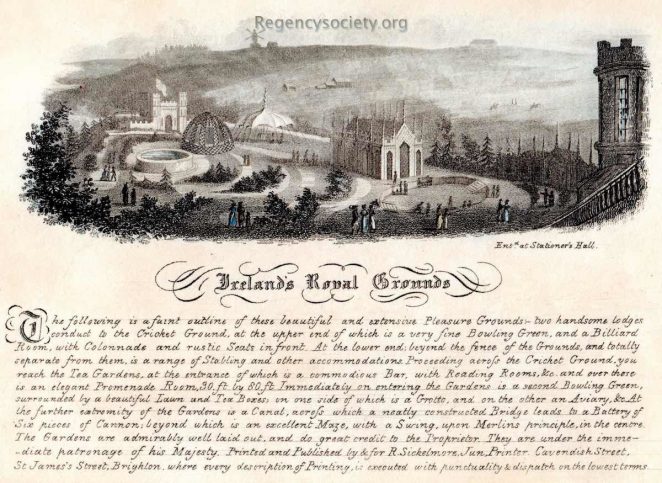In Union Street, opposite The Level’s north end, is a wrought iron gate which is permanently locked and apparently unused. Either side of the gate are two large pillars on which stand lion statues. The entrance has the air of genteel poverty, a sad reminder of past glory days, which indeed they are. The image below and accompanying text illustrate the original gardens and also the entertainments which were available there.
Brighton’s increasing popularity
This was the site, in 1823, of Ireland’s Pleasure Gardens, also referred to as the Royal Pleasure Gardens, as it was ‘under the immediate patronage of His Majesty’. This splendid place of entertainment was built on a 10acre site purchased from Thomas Read Kemp. The owner James Ireland, was a wealthy businessman, who hoped that Brighton’s increasing popularity as ‘the place to be’ would ensure the success of his venture.
Building development in the 1840s
Unfortunately for Ireland, this was not to be, disenchanted with his project he sold it in 1826. Eventually, after the further decline of the business, the gardens were closed in the 1840s. In 1849 work commenced on the development of a horseshoe-shaped, three-part terrace of houses designed and built by Amon Henry Wilds. The residents of these houses in Park Crescent today, can still enjoy the extensive gardens.
Transcription of the above text
The following is a faint outline of these beautiful and extensive Pleasure Grounds – two handsome lodges conduct to the Cricket Ground, at the upper end of which is a very fine Bowling Green, and a Billiard Room, with Colonnade and rustic Seats in front. At the lower end and beyond the fence of the Grounds, and totally separate from them, is a range of stabling and other accommodations. Proceeding across the Cricket Ground, you reach the Tea Gardens, at the entrance of which is a commodious Bar, with Reading Rooms, Etc., and over these is an elegant Promenade Room 30 ft by 80 ft. Immediately on entering the Gardens is a second Bowling Green, surrounded by a beautiful lawn and Tea Boxes, on one side of which is a Grotto, and on the other side an Aviary etc. At the further extremity of the Gardens is a Canal, across which a neatly constructed Bridge leads to a Battery of six pieces of Cannon, beyond which is an excellent Maze, with a Swing, upon Merlin’s principle, in the centre. The Gardens are admirably well laid out and do great credit to the Proprietor. They are under the immediate patronage of His Majesty.
Reproduced with permission; The Regency Society &The Society of Brighton Print Collectors






Comments about this page
Fascinating reading, thank you Jennifer. I pass the gates most days and never even knew the existence of the garden’s pre-Park Crescent magnificence! Please could someone explain what makes a swing “upon Merlin’s principle”? I tried to locate it on the illustration.
In the early-mid 19th century The Gardeners Magazine made several visits to Brighton. The editor John Claudius Loudon noted in vol XVIII 1842 p349- ‘Notes on Gardens at Brighton’- The Royal Tea Garden in the outskirts of the town is on a level surface, and might be made a scene of considerable attraction. It has been ten or twelve years planted, and the trees are 30ft high and upwards, and thriving as well as could be desired. There is a handsome broad straight walk down the centre of the garden, completely and densely shaded by elms; a great variety of side walks and side scenes, such as open circular areas of gravel, of flower-beds, of arbours and other rustic structures, of basins of water etc. There is a sunk oval area of turf, 100ft by 200ft, surrounded by an open lawn, which may serve as a verdant amphitheatre, or for a large company to see a play acted on a temporary platform , to hear music, or see fireworks, for a dance, a fancy fair, a masquerade, or other amusements. There is a labyrinth, at the farther extremity of the garden, and a large building for refreshments at the main entrance. It does not, however, seem in a thriving state, for most of the wooden structures are tumbling to pieces, and the flower-beds were neglected, and, instead of a gardener among them, we found a cow.’
Add a comment about this page